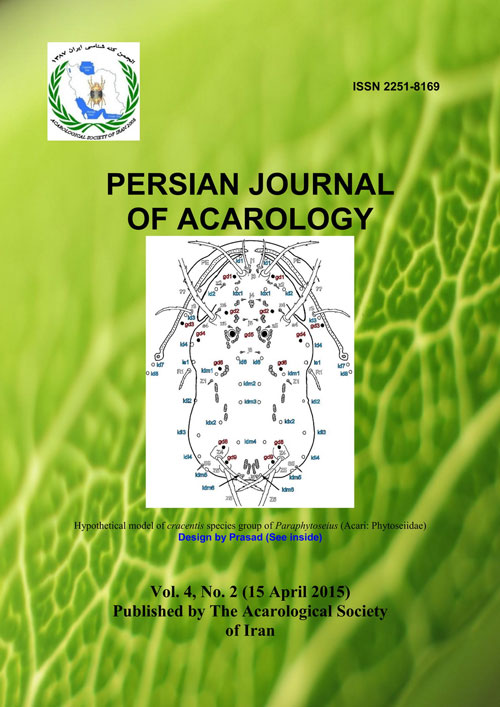فهرست مطالب

Persian Journal of Acarology
Volume:4 Issue: 2, Spring 2015
- تاریخ انتشار: 1394/04/30
- تعداد عناوین: 9
-
-
Page 143Paraphytoseius nicobarensis (Gupta, 1977) is considered to be a junior synonym of Paraphytoseius cracentis (Corpuz & Rimando, 1966). Voucher photos of holotype female, a paratype female, and a paratype male are provided. Difficulties in the identification of seta S5 are discussed. Suggestions are made for researchers to take voucher photos of the holotype specimens and for museums to place these online along with a searchable database of the mites in their collection for benefit of researchers worldwide.Keywords: Paraphytoseius nicobarensis, P. cracentis, voucher photos, seta S5, solenostomes gd5, gd8, lyrifissure idm5
-
Page 163Many photos of solenostomes and lyrifissures, including large gd5, present in female and male Paraphytoseius santurcensis De Leon, 1965, that lacks seta S5, are given. A hypothetical model of Paraphytoseius having seta S5, as in P. cracentis (Corpuz and Rimando, 1966), is included in a line drawing showing all the solenostomes and the lyrifissures that may be present in a species of this genus.Keywords: Adenotaxy, lyrifissure, poroidotaxy, porotaxy, proprioreceptor, sigilla, solenostome gd5
-
Page 189Aegyptobia hamus is redescribed from new materials which were collected on Fallopia convolvulus (Polygonaceae) in Iran, representing a new country and host record for this species.Keywords: Flat mites, host record, new record, Prostigmata, Tetranychoidea
-
Page 197Hygrobates quanaticola is redescribed from new materials collected in Iran. Additionally, the description of the deutonymph is provided. This is the first report of this species from lotic waters.Keywords: Hydrachnidia, Prostigmata, Water mites, Rivobates, lotic, lentic waters
-
Page 205Ixodid ticks are obligatory blood-sucking ectoparasites of various mammals, birds, reptiles and vectors of different agents of diseases in both man and livestock. Ixodes hexagonus was reported from different parts of the globe and it is important as a vector of different diseases such as Lyme disease. A total of 53 chukars were sampled. The birds were obtained from hunters or dealers on different occasions from several localities across the south of Urmia city, West Azerbaijan of Iran. In this study, we report infestation of I. hexagonus in chukar and it is the first report of I. hexagonus from Iran. The results indicated that 28 chukars were infected by ticks. Considering that the I. hexagonus is one of the major vectors of Borrelia burgdorferi, Babesia microti and Rickettsia conori, the report of this tick in this region could mean more disease transmission. More attention should be given to the search of this parasite in similar geographical regions in Iran. Additionally, molecular work should be done to show the importance of I. hexagonus tick in the transmission of different diseases especially Lyme borreliosis.Keywords: Female, infestation, larva, Lyme disease, nymph, ticks
-
Page 213The soft tick, Argas persicus, is the most important ectoparasite in chicken and other domestic fowl, well as in humans. The main aim of this study was to evaluate the survival rate of A. persicus under three different environmental conditions, including immersion in tap water, immersion in oxygenated water and after being placed and washed along clothes in an ordinary washing machine. Adult and larval ticks were separately immersed in tap and oxygenated water for six different time periods: 1, 6, 24, 48, 72 hours and 1 week. Both adults and larvae survived up to 72 hours immersion in tap water. All the ticks immersed in tap water died during the first week; while 53.3% of adult ticks survived one week immersion in oxygenated water. To evaluate the survival rate of ticks in the washing machine, only adults were used and the ticks were placed in a small hub filter before being placed in a Samsung washing machine at three different temperatures (30, 40 and 60°C). At the end of each cycle, we counted the surviving ticks. All ticks survived 30 and 40 °C, while only 13.3% survived at 60 °C. In conclusion, adult and larval stages of A. persicus survived under water for couple of days while washing in regular washing machine did not kill adult ticks under temperatures of 30 and 40 °C. So in order to kill the ticks in clothes temperatures more than 60°C should be used.Keywords: Argas persicus, chicken, domestic fowl, ectoparasite, tick, survival rate
-
Page 221The life history of Bryobia rubrioculus Scheuten (Acari: Tetranychidae) on sour cherry leaves was studied based on the age-stage, two-sex life table at nine constant temperatures (15, 17.5, 20, 22.5, 25, 27.5, 30, 32.5 and 33.5 ºC), 60 ± 5% RH and a photoperiod of 16: 8 (L: D) h. The longest and shortest total development time of the mites were obtained as 62.6 ± 1.66 and 14.2 ± 0.20 days at 15 and 32.5 ºC, respectively. As temperature increased from 15 to 32.5 ºC, the life span of the mites decreased from 83.5 ± 2.14 to 24.7 ± 0.39 days, respectively. The highest and lowest total fecundity was observed as 37.3 ± 1.63 and 6.3 ± 1.06 eggs at 17.5 and 15 ºC, respectively. The highest intrinsic rate of increase (r) was obtained as 0.1108 ± 0.005d-1 at 30 ºC. The mean generation time (T) ranged from 78.1 ± 2.8 to 19.1 ± 0.2 days at 15 and 32.5 ºC. Survi-vorship data (lx) of adult females were summarized and compared using the shape and scale parameters of the Weibull frequency distribution model. The lower temperature threshold (t) and thermal constant (k) of the immature stages were estimated using the Ikemoto and Takai linear model to be 8.9 ºC and 361.3 degree days (DD), respectively. The optimum temperatures were calculated by selected nonlinear models including Analytis1/Allahyari, Hilbert and Logan, and Logan-6 models to be 33.10, 33.90 and 32.40 ºC, respectively.Keywords: developmental time, life table, Prostigmata, temperature, thermal constant

